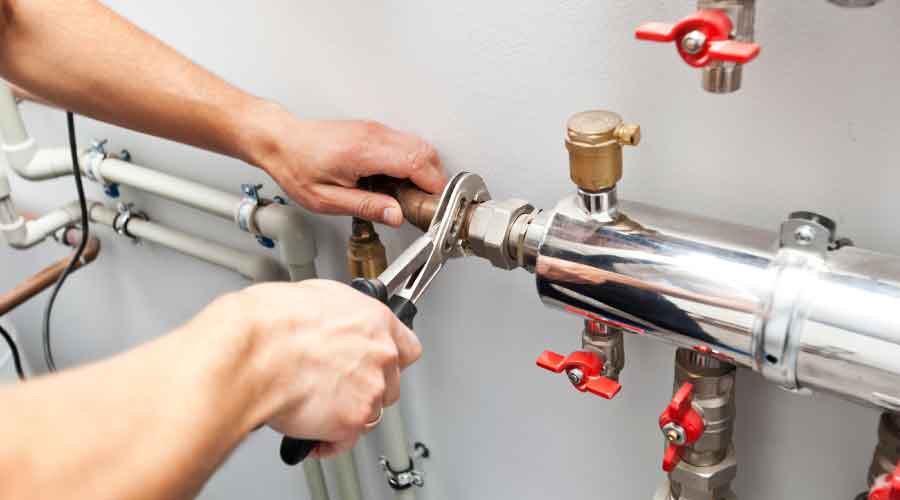Navigating the Challenges that Surround Plumbing
Retrofits can be costly up-front projects, but when performed correctly and monitored regularly, you can quickly recoup your investment through savings on your water and energy bills.
Plumbing and restroom upgrades are notoriously complex challenges for managers, given their cost and the expectations for water conservation. The John Ferraro Building projects met the challenge.
“The upgraded plumbing fixtures have exceeded expectations,” Sison-Roces says. “Total water consumption for the building was reduced by 10.4 acre feet per year. The estimated savings of the LADWP water conservation plumbing retrofit project is 60 acre feet per year, with accumulative savings of 494 acre feet of water since the beginning of the project.”
The project’s success contributed to the decision by the department to pursue recognition for their overall sustainability efforts.
“In 2014, LADWP committed to obtaining LEED Existing Buildings: Operations and Maintenance certification for the building by its 50th anniversary date in June 2015,” Sison-Roces says. The pursuit paid off, as the building achieved LEED Certified rating on the 50th anniversary of its construction in 2015 and LEED Gold a year later in 2016. In 2019, the building also became the first building in California to achieve LEED Zero status.
Beyond plumbing
The effort to earn LEED certification went well beyond upgrades to plumbing and water-distribution systems.
“This cross-functional effort leveraged energy- and water-efficiency improvements completed over the years, including lighting retrofits, green plumbing and toilet retrofits, fan system upgrades, and the installation of an energy efficient chiller,” Sison-Roces says.
LADWP’s facilities operation and maintenance personnel worked with the energy efficiency engineering group to identify and analyze a suite of energy efficiency measures for the building. Most measures were implemented throughout 2014 and completed in the first quarter of 2015. Among them were these projects:
Fan system variable-frequency drive and static pressure control. The control strategies were designed and implemented to allow the major fan systems to slow down via variable-frequency drives during occupied hours by using the static pressure demand as a set point. Estimates show 6.9 GWh and 590 kW demand savings through the full duration of the project from 2008-2015, with a one-year payback after utility incentives.
Fan system economizer damper control. LADWP operation and maintenance workers replaced all rusted and inoperable outside air dampers and actuators. These measures are estimated to save 774,000 kWh annually with a four-month payback after utility incentives.
Lighting schedule change and half-hour daily reduction. LADWP has reduced the lighting schedule for all indoor areas by 30 minutes. This change resulted in approximately 6,110 kWh of energy savings, with a six-month payback after utility incentives.
Daylight harvesting controls programming was implemented in existing building automation systems and lighting circuitry to use daylight to offset the amount of electric lighting needed to properly light private perimeter offices. These measures are estimated to save 195,570 kWh annually and net a 70 kW demand reduction.
Chiller upgrade. Based on analysis of chiller efficiency and power curves, LADWP selected a new chiller that incorporates multiple oil-free, magnetic bearing, centrifugal compressor technology in its design. EE Engineering estimates 2,872,110 kWh of annual energy savings and an increase in coincident peak demand by 165kW resulting from the chiller replacement. After utility incentives, the total cost of the measure is estimated to pay back in 3.2 years.
LADWP’s sustainability efforts in the John Ferraro Building have continued beyond the plumbing and water-distribution system upgrades and the LEED certification.
“A recent example of a sustainability project is the addition of six aeroponic pods in the cafeteria patio," says Sison-Roces, adding the project began during the pandemic. “The pods were donated by LA Urban Farms and Sensible Sages in 2021 and have since been maintained by the LADWP green team in collaboration with LADWP’s landscaping group. To date, LADWP green team has donated over 750 pounds of produce to Los Angeles food pantries.”
Dan Hounsell is senior editor of the facilities market. He has more than 25 years of experience writing about facilities maintenance, engineering and management.
Related Topics:













